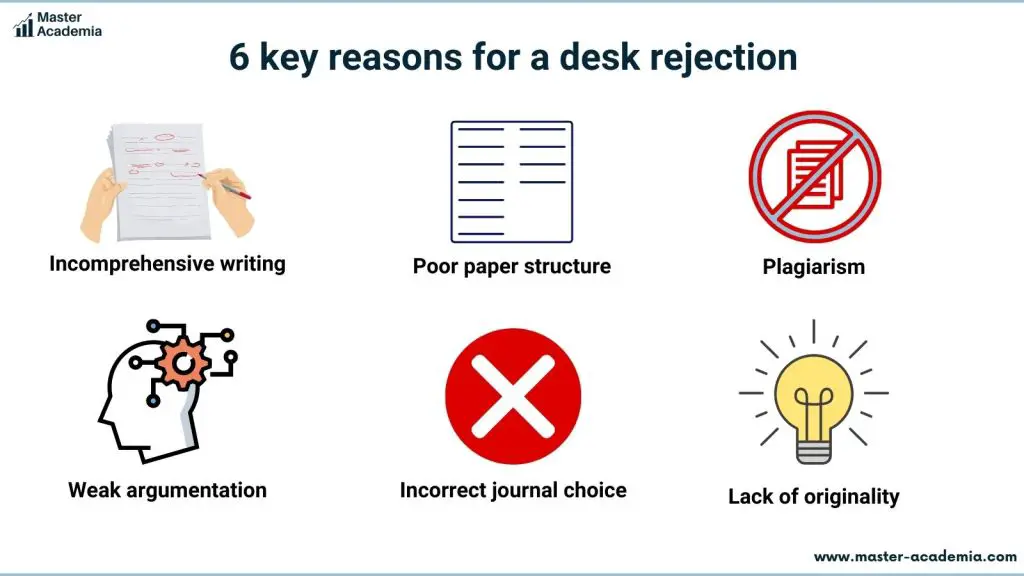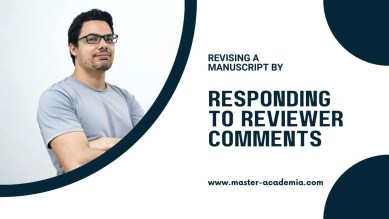
Desk rejection occurs when your academic paper is rejected by journal editors before undergoing peer review. To overcome the emotional impact, you can improve your paper by understanding the reasons for rejection, seeking feedback, utilizing professional editing services, and deciding whether to resubmit to the same journal or a different one. Maintaining composure and confidence in your abilities is crucial throughout this process.
Disclosure: This post has been sponsored by Editage. I only recommend products or services that I truly believe can benefit my audience. As always, my opinions are my own.
Contents
- What does it mean if an academic paper is desk rejected?
- The emotional toll of having a paper desk-rejected
- 6 key reasons for a desk rejection
- Reading or requesting feedback after a desk rejection
- Improving a paper after a desk rejection
- Submitting a paper again after a desk rejection
- Overview of steps to take to rework a desk-rejected article
What does it mean if an academic paper is desk rejected?
When academics and researchers submit their manuscripts to academic journals, the papers undergo a review process by journal editors. If the paper meets the initial criteria, it proceeds to external reviewers and subsequent stages of the publication process. However, this is not always the case.
In some cases, submitted academic papers are immediately rejected by journal editors before entering the peer review process, which means the papers got desk-rejected.
This can be disheartening for authors as it indicates that the manuscript was not deemed suitable for further assessment or lacked quality. It can be emotionally challenging, particularly for young researchers.
Nonetheless, a desk rejection is not the end of the world. With some actionable steps, the rejected paper can be improved in a way that it stands a fair chance of being published as an academic article when it is submitted to a journal again.
However, before embarking on the process of improving the paper, it is important to overcome the initial disappointment and emotional impact of the desk rejection.
The emotional toll of having a paper desk-rejected
Experiencing a desk rejection for your paper can be a challenging and unpleasant experience. It is important to remember that such setbacks are common in academia and even the most accomplished researchers have faced them at least once in their career. This can be particularly tough for early-career researchers.
When faced with a desk rejection, it is crucial to acknowledge and address your emotions before moving forward. Take the time to process your feelings and approach the situation step by step.
Avoid punishing yourself or ignoring the rejection altogether. Instead, consider opening up and discussing your experience with others, such as your supervisor or colleagues. They may have their own stories of facing desk rejections, which can provide comfort and reassurance.
Taking a break from your paper is perfectly acceptable. Give yourself some space by setting it aside for a couple of weeks.
Once you have healed from the initial disappointment, you will be better equipped to tackle the project and prepare it for resubmission. This process begins with understanding the reasons behind the desk rejection in the first place.
Remember, a desk rejection does not define your abilities as a researcher. It is a temporary setback that can serve as an opportunity for growth and improvement. With time, support, and a renewed perspective, you can regain your momentum and continue working toward success in your academic endeavors.
You may also like: How to find a reputable academic dissertation editor
6 key reasons for a desk rejection
Once you feel emotionally prepared to address your desk-rejected paper, it is crucial to understand the common reasons why academic manuscripts are often desk-rejected.
There are six key factors that can lead to desk rejections:
- Incomprehensive writing: Even if you possess brilliant scientific insights, if you struggle to articulate them clearly and cohesively on paper, readers may find it difficult to follow your work. This lack of clarity and effort in writing can result in immediate disqualification and desk rejection.
- Poor paper structure: While individual sentences may be well-written, if your paper lacks a logical structure and fails to guide the reader effectively, it can hinder comprehension. Each journal has its own preferred structure, which can be observed in their published articles.
- Plagiarism: Plagiarism is strictly prohibited in academia. Journals tend to check submitted manuscripts for plagiarism to avoid future complications. If a paper is flagged for plagiarism, it is often desk-rejected immediately. (Even if the text is plagiarized by accident, for instance through improper paraphrasing).
- Weak argumentation: Weak argumentation indicates a lack of critical feedback prior to submission. It is beneficial to have subject-matter experts review and provide feedback on your paper before submission. This ensures that your work meets disciplinary standards, presents a clear and compelling argument, and contributes significantly to the field.
- Incorrect journal choice: Choosing an appropriate journal for your research is crucial. As a PhD student, it is essential to understand how to select a journal that aligns with the scope and focus of your study. For example, it makes no sense to submit a quantitative study to a journal that purely publishes qualitative research.
- Lack of originality: Academic journals prioritize the advancement of science through novel contributions. Even if your paper is well-structured and formatted, if it does not offer a fresh and original perspective, it may be desk-rejected. Journals aim to avoid repetition of existing knowledge, even if presented in slightly different ways.
By understanding these reasons, you can critically assess your paper and address any shortcomings before resubmitting it.

Reading or requesting feedback after a desk rejection
Once you have a clear understanding of the common reasons for desk rejections, it is important to analyze why your manuscript specifically received a desk rejection.
Reputable journals typically provide feedback in the form of one or two brief paragraphs to explain their decision. This feedback is valuable in understanding the shortcomings of your paper and guiding you in the revision process before resubmission.
Avoid the temptation to simply submit your paper to a different journal without making any changes. Consider whether the editor may have misunderstood your intentions and strive to improve clarity in your writing.
Even if you disagree with the reviewers or editors, it is essential to approach the desk rejection as a learning opportunity.
In cases where no feedback is provided, it is acceptable to politely reach out to the editor and inquire if it would be possible to receive some brief feedback on the reasons for the desk rejection. Send a friendly email expressing your desire to learn from the experience and improve your paper.
Challenging a desk rejection is rarely fruitful, as journals are unlikely to reverse their decision. It is crucial to refrain from attacking the journal or the editor. Remember that they can associate your name and affiliation with your correspondence, so it is important to maintain a professional and respectful tone, even if you feel disappointed.
Improving a paper after a desk rejection
While the feedback received with a desk rejection is often concise, it is valuable to approach it in a similar manner as you would handle reviewers’ comments during peer review.
One effective strategy is to create a table to break down the feedback into specific points that can be linked to actionable steps. Keeping track of all the changes and edits made based on the feedback is also beneficial.
Considering the key reasons for desk rejections, which often relate to writing style, such as incomprehensive writing, poor structure, accidental plagiarism, and weak argumentation, it is advisable to have your manuscript professionally edited before resubmitting it elsewhere.
Professional publication support, like that provided by Editage, can significantly increase your chances of acceptance. Editage offers services for editing and formatting your manuscript, conducting professional plagiarism checks, ensuring proper formatting of graphs and figures to meet journal requirements, and reviewing your journal choice.
Additionally, it is highly valuable to have your manuscript undergo a review before submission. For PhD students, supervisors should provide this review, but seeking feedback from colleagues and peers can also be advantageous.
If you do not have access to skilled peer review before formally submitting your improved manuscript to a journal, consider utilizing professional services like those offered by Editage.
Having knowledgeable individuals from your field conduct a thorough scientific evaluation of your paper, analyzing its novelty, ethical compliance, contribution to the research field, and readiness for journal submission is crucial.
Submitting a paper again after a desk rejection
Once you have improved your paper, it is important to consider where to submit it. Essentially, you have two options:
- Resubmitting to the same journal: This option is suitable if the paper was initially rejected due to factors such as language quality or argumentation. If you still believe that the original journal is the best fit for your paper, you can attempt to submit it again. In your letter to the editor, clearly state that you are resubmitting the manuscript after a desk rejection, and outline the improvements you have made. Explain why you believe the paper now meets the required standards and can make a valuable contribution to the journal.
- Submitting to a different journal: This option is preferable when the desk rejection resulted from a mismatch between the manuscript and the aims and objectives of the journal. Even if the original journal seemed appropriate, you may decide to pursue a fresh start at a different journal. Through the feedback and editing process, you might discover that your paper aligns better with a different journal’s scope and focus.
There is no definitive recommendation as to whether option 1 or 2 is better or leads to a higher success rate. The choice depends on your specific circumstances and aspirations. Consider factors such as the target audience, the journal’s reputation, and the potential impact of your research when making your decision.
Overview of steps to take to rework a desk-rejected article
- Acknowledge the disappointment that comes with a desk rejection. Remember that rejections are a common part of the academic journey.
- Take the time to thoroughly read the feedback provided for your desk rejection, or kindly request feedback if it has not been provided. This feedback will provide valuable insights into areas that need improvement.
- To enhance your paper, seek feedback from your supervisor and peers. Additionally, consider utilizing professional editing and publication support services provided by Editage to refine your work.
- After making the necessary improvements, carefully choose the journal to which you will submit your revised paper. Submit it with confidence.
- Keep calm and wait to hear back from the journal. Understand that setbacks are part of your academic journey and should not diminish your faith in your abilities. You got this!



